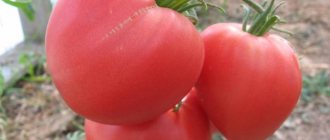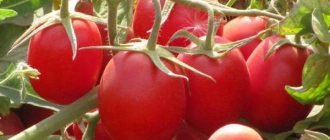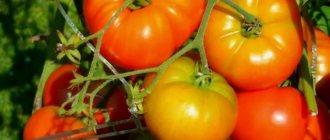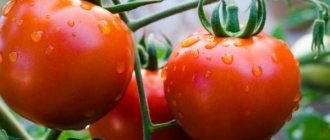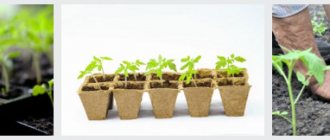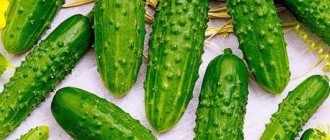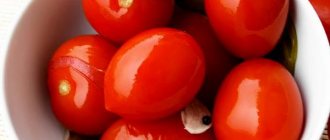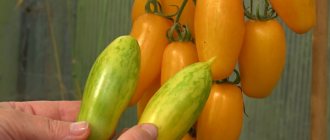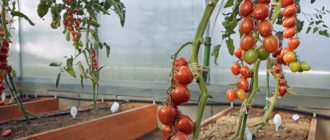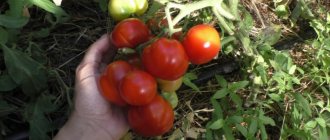Seed selection
Growing tomatoes begins with sowing seeds for seedlings. The seed remains viable for 7-9 years, but it is better to use 2-year-old seeds.
The variety must be zoned. In this case, the tomatoes will hurt less, have time to fully ripen and bear fruit.
For northern regions with short summers, only ultra-early and early tomatoes are suitable.
The choice is also determined by where the tomatoes will be grown. Breeders have developed varieties intended for greenhouses and open ground:
- Tall (indeterminate) varieties with unlimited growth are recommended to be planted only in a greenhouse, followed by tying them to a trellis.
- Standard tomatoes are an excellent choice for open ground. Compact bushes do not require tying or pinching and are not damaged by the wind.
Tomatoes also differ according to their intended purpose:
- There are varieties suitable exclusively for salads and fresh consumption.
- Other varieties are bred specifically for canning and pickling. As a rule, these are medium-sized tomatoes with elastic flesh and dense skin that is not subject to cracking.
- There are also universal varieties.
You can study and select the appropriate variety or hybrid for sowing in the Tomato Catalog.
Group of indeterminate tomatoes
Characterized by unlimited growth of the main stem. Such varieties require the formation of a bush. All the stepsons are torn off from them, creating one stem. Over time, the bushes need to be tied to a support.
Flowering in indeterminate varieties occurs at the stage of 9-10 leaves, and the formation of clusters occurs every third leaf.
The most popular indeterminate varieties of tomatoes for open ground
- Hybrid Wonder of the World. Tomatoes have an unnatural shape and color. They look like lemons. Many gardeners call this garden crop lemon vine. The weight of one tomato varies from 50 to 110 grams. Up to forty-five fruits can be formed on the lower clusters, and up to twenty-five on the uppermost ones. Tomatoes of this type are pickled and canned.
- Tarasenko 2 . The bushes are tall. Up to 35 fruits ripen on each cluster. Orange-red tomatoes with thick skin and sweet flesh. The weight of one tomato is 60-70 grams. Tomatoes of this variety are perfectly stored and transported. The bushes are productive and medium-sized.
- De-Barao Yellow is a medium-sized hybrid with medium-late fruit ripening. Fruiting occurs 4 months after sowing the seeds. The tomatoes are dense, orange, oval in shape, weighing up to 60 grams. They have good shelf life and tolerate transportation well.
- De Barao Royal pink. The fruits are shaped like peppers. Pink and sweet tomatoes weighing up to three hundred grams. Up to five kilograms of tomatoes ripen on one bush. High-yielding bushes.
Preparing seeds and soil
The soil for seedlings must be nutritious, loose, and disinfected.
- You can buy all-purpose soil for seedlings at a garden center and steam it in the oven or microwave.
- Some summer residents simply spill boiling water or a solution of potassium permanganate on the soil.
First you need to sort the seeds:
- To do this, use a saline solution prepared from 1 glass of water and 1 teaspoon of salt.
- The seeds placed in it are left for 20 minutes.
- After the specified time, all damaged, weak and empty seeds will float to the surface, and high-quality material will settle to the bottom.
- After this, the good seeds are washed and soaked for 30 minutes in a 1% solution of potassium permanganate or hydrogen peroxide.
- They are then left in the water overnight and planted in the morning.
Sowing seedlings
To grow in a greenhouse, tomato seeds are sown at the end of March; for open ground, sowing is done in the first ten days of April.
You can pre-germinate them by wrapping them in a damp cloth. This process will take 3-4 days.
You can plant seeds in plastic containers and wooden boxes. It is better to give preference to plastic - such containers are easy to wash and disinfect. There must be drainage holes in the bottom of the container, and a tray underneath.
Some people use ordinary plastic or peat cups for planting. A drainage layer of expanded clay must be placed at the bottom of any container to prevent rotting of the delicate roots.
Then the container or cups are filled with slightly moistened soil and sowing begins:
- 2-3 seeds are immediately planted in separate containers, then the weaker shoots are removed, leaving the strongest seedling.
- In the container, grooves are cut with a wooden stick at a distance of 4 cm from each other. The depth of the grooves should be 1 cm.
- Seeds are placed in them at intervals of 2 cm, after which they are sprinkled with a thin layer of fertile soil and lightly moistened with a spray bottle.
The best way to sow seeds for seedlings. Sowing tomatoes - video
Features of selection of pink varieties
Breeding of pink tomatoes is currently underway to develop the best varieties to meet the needs of the modern seed market. The gene pool of pink varieties needs to be expanded. And the main method of selection for the southern regions of Russia - intervarietal stepwise hybridization using red-fruited varieties - is carried out in two directions.
- Creation of hybrids that do not require support for open ground and small greenhouses. Domestic varieties of pink tomatoes of this type, adapted for cultivation in Russia: F1 Panticapaeum, F1 Pont (early ripening), F1 Pragmatist (medium ripening), F1 Friday (medium late).
- Creation of hybrids for growing on a trellis. Varieties of pink tomatoes of this type: F1 Rosaletta (early), F1 Rosemax (mid-early), F1 Rolex (medium), F1 Rosebeef (mid-late).
Of the foreign pink hybrids, it is worth noting Shedy Lady F1, Lenore F1, Orko F1, Otranto F1. The tarpan f1 tomato, an early bush tomato, fleshy and extremely tasty, is very popular. The plant is compact, the fruits weigh on average 130-180 g.
Seedling care
Shoots appear 5-7 days after sowing.
Until the seedlings emerge, the box with seedlings is kept at room temperature, then the temperature is reduced to 12-15 degrees during the day and 8-10 degrees at night.
When the seedlings get a little stronger, the temperature is again raised to 20-25 degrees.
The recommended air humidity for growing seedlings is 60-70%.
At two weeks of age, the seedlings are planted in separate cups.
Feeding:
- After 10 days, the first fertilizing is carried out with a mixture of potassium salt, superphosphate and urea.
- After another 2 weeks, the tomatoes are fed a second time.
Water the seedlings with warm water in the first half of the day. Watering should be plentiful, but rare.
Plants are planted in the garden at the age of 65-70 days.
On a note! By the time of planting in the ground, the bushes should have a developed root system, many buds on the first cluster, a thick stem, and dark green leaves.
The best ultra-early ripening varieties of tomatoes
Particularly popular are the recently developed ultra-early varieties for cultivation in open ground. They are used for planting in regions with harsh climates and sudden temperature changes. The first harvest of tomatoes can be obtained no earlier than 3 months from the moment the seeds are planted.
Hybrid Sanka
- Hybrid Sanka . The plants are ultra-early ripening, compact in shape, up to fifty centimeters high. Seedlings are planted close to each other. Red fruits are smooth and round in shape, four-chambered, without a green spot at the stalk.
- Valentina. A determinate crop that is disease-resistant and tolerates drought. The bushes are short - up to seventy centimeters, productive, spreading. This variety does not require pinching. The fruits do not crack, have a dense structure, and are shaped like a plum. The weight of one fruit is about one hundred and twenty grams.
- Hybrid Far North. The beginning of fruiting occurs 3 months after planting the seeds. The bushes are standard, determinate, 70 cm high. The fruits are red, round, weighing up to 70 grams. This is a cold-resistant variety and is not susceptible to late blight.
- Amur standard is an ultra-early ripening hybrid. The fruits ripen 90 days after sowing the seed. The bushes grow up to 50 centimeters in height and are highly productive. The fruits are red and round in shape. The weight of one tomato is about 80 grams. Amur standard tomatoes are consumed fresh and also for preparing various dishes. This is an easy-to-care plant. Regardless of weather conditions, it produces a bountiful harvest of delicious tomatoes.
Such a variety of varieties with increased resistance to negative weather conditions makes it possible to grow tomatoes not only in regions with a warm climate, but also in the far North.
We wish you success and great harvests!
Landing at a permanent place
In order for tomatoes to produce a good harvest and not get sick, it is necessary to observe crop rotation. The best predecessors for them will be root vegetables (excluding potatoes), all types of cabbage, and perennial herbs.
The soil should be neutral or slightly acidic. Light and fertile soil contributes to earlier harvesting.
Tomatoes are planted in open ground after the threat of frost has disappeared; the seedlings must first be hardened.
At first, it is recommended to cover the plants with film or agricultural material to protect them from the cold.
Drop off rules:
- Most often, tomatoes are planted in two rows with an interval between plants of 25-30 cm.
- Row spacing should be 50-65 cm wide.
- Seedlings should not be buried more than 4-5 cm compared to the initial planting.
- Overgrown seedlings are planted obliquely, with their crowns facing north.
After planting, make sure that a hard crust does not form; the soil is regularly loosened after watering.
In open ground
15-20 days after planting, the tomatoes need to be hilled; in the future, this procedure is carried out twice more. Simultaneously with hilling, mineral fertilizers are applied. Their deficiency can be identified by the appearance of the plants.
Tomatoes do not like irrigation by sprinkling; moisture is applied strictly at the root. The culture requires rare but abundant watering. You can determine the need for moisture by the appearance of the tomatoes - the leaves darken and become drooping.
On a note! With excess moisture, gray rot and late blight can develop; insufficient watering can provoke the appearance of blossom end rot.
For the first 10-15 days after planting the seedlings, tomatoes do not need to be watered; the moisture added during planting will be enough for them. With the appearance of ovaries, the need for water in tomatoes increases sharply. At this time, the plants are watered at intervals of 5-7 days, adding up to 5 liters of water under each bush.
To retain moisture in the soil during the fruiting period, mulching is used. When low-growing tomatoes begin to yield, watering is reduced. With determinate varieties, the opposite is done, giving them more water during this period.
Tomatoes can be formed into one, two or three stems.
- All stepsons are removed, not allowing them to grow more than 5 cm in length.
- This procedure must be performed in the morning on a sunny day so that the wounds heal before evening.
- Stepchildren should not be torn off by hand, so as not to damage the stem. Typically, sharp pruning shears or small scissors are used.
Standard forms do not need to be formed.
For preventive purposes, bushes are sprayed two or three times a season with Bordeaux mixture or a solution of any copper-containing preparation. The need for this measure increases after the rainy period.
Low-growing tomatoes for open ground
As a rule, low-growing determinate species stop growing after the formation of the fifth cluster on the bush. The first flower cluster in such plants appears after the seventh leaf. The laying of each previous one occurs every second sheet.
Determinate plants are divided into two groups:
- Super-determinant - early ones that do not need pinching.
- Determinate - required in the formation of a bush and the removal of excess stepsons.
The most important advantage of such plants is the early and complete yield of the crop. It is also important that determinate species are suitable for cultivation both in open ground and in a greenhouse.
The most popular productive low-growing tomatoes for open ground
Tomato Hybrid Mystery
Hybrid Mystery. One of the most valuable varieties. Colorful, smooth, rounded tomatoes ripen in a short time, have an excellent presentation, and are transportable. In terms of taste, this hybrid is not inferior to any early ripening variety. On average, the weight of one fruit is about 150 g. The ripening period of tomatoes from the moment the seeds are planted until the harvest is 2.5 months. The bushes are low-growing, characterized by rapid growth and development. The average height of one bush is forty-five centimeters. The bushes are large and well leafy. Due to the low growth and strength of the stems, there is no need for staking material.
Along with the advantages, this culture also has one disadvantage - the significant formation of stepsons that need to be removed from time to time. Therefore, the Riddle hybrid needs constant and timely care. It is important that the severed stepsons take root very well. From them you can get additional fruit-bearing bushes. The daughter plants will lag behind the main bushes in growth and development by only 1-2 weeks. Even so, you don’t have to do any pinching of plants, but the fruits will simply be smaller.
Crimson Giant
Raspberry Giant is a large-ripening species with early ripening of tomatoes. High-yielding bushes. This is probably the only hybrid with large fruits belonging to this group. The weight of one tomato is about 700 grams. Six fruits are formed on one cluster. Brushes are formed on every third sheet. The fruits are pink, early, very tasty and aromatic, but of different shapes, sometimes flattened in height or on the sides. With proper care, it is possible to remove up to 15 kg of tomatoes from one bush. The ripening period is 4 months. The Crimson Giant has increased resistance to disease.
Anastasia is an extremely early tomato variety. The plants are tall, determinate, and can be formed into 1-2 stems. A productive hybrid - ovaries are formed every two leaves. 7-8 tomatoes are formed on one brush. On average, the weight of one fruit is two hundred grams. By providing the plantings with appropriate care, it is possible to reap a rich harvest - up to 12 kg of tomatoes from one bush. The fruits are red with sweet pulp and have a characteristic tapering at the tip.
Roma
Roma is a mid-season variety bred by Dutch breeders. Cream fruits take a long time to ripen. The weight of one tomato is 80-110 grams. Up to twenty tomatoes are formed on one brush. They are happily used for pickling and preparing for the winter. The bushes are medium-sized standard.
Rio de Grande
Rio de Grande is a universal garden crop. Tomatoes can be consumed fresh, as well as for processing and canning. Low-growing plants reach 60 cm in height. The fruits are creamy, smooth, not large and sweet in taste. The weight of one fruit is 115-125 grams.
Bobcat F1
Bobcat F1 is a Dutch hybrid. It is classified as a high-yielding variety. Each fruit weighs about 250-300 grams. Valued for its ease of care and growing conditions. Bobcat F1 is resistant to adverse weather conditions, as well as to diseases such as vercillosis, fusarium and alternaria.
All of these are the best low-growing tomato varieties belonging to the determinate group. The maximum height of bushes of such plants is 1 meter. They don't need support. Thanks to the small bush and small root system, low-growing varieties take up little space on the site.
Vigorous and rapid ripening of fruits helps protect the tomato crop from late blight, which attacks plantings in August.
The most cold-resistant varieties, for example, Raspberry Gigant and Bobcat F1, can be sown directly into the ground under film cover in late April - early May.
Low-growing early determinate hybrids require a minimum of care. And only a few of them need pinching and gartering. Obtaining an early, environmentally friendly harvest in a short time is one of the main advantages.
To the greenhouse
When grown in a greenhouse, plants need to be tied to a trellis a week after planting.
Greenhouse tomatoes must be shaped.
- Indeterminate varieties are pinched above the 5th brush, leaving two leaves on top.
- Determinate varieties are formed in such a way that there are 4-5 brushes left on the bush.
The lower yellowed leaves are periodically torn off. Watering is carried out in the first half of the day, after which the greenhouse is ventilated.
Root dressings are applied three times per season. As a top dressing, you can use mineral complexes, liquid organic fertilizers, and an infusion of mowed grass.
For more successful pollination, the bushes are shaken during flowering.
Harvesting
Harvesting is done every 3-5 days as the fruits ripen. You can pick tomatoes at the stage of technical maturity, when the skin begins to turn red, brown or yellow. Lying in the sun, such fruits will fully ripen and will not differ in taste from those that ripen on the bush.
If you pick tomatoes green, it will be impossible to get the same taste from them.
- Early ripening varieties begin to ripen in the second half of July, and from mid-August the bushes begin to die off. If the weather forecast is unfavorable and a sharp cold snap begins, it is better to remove all the saturated fruits the day before.
- In mid-season varieties, the fruiting period shifts two weeks ahead.
- Late tomatoes and giants are harvested in August when grown in open ground. They can be left in the greenhouse until September.
Urgently remove the fruits if late blight symptoms appear on the leaves, otherwise you may lose the entire harvest.
Tomatoes can be stored in a cool room for up to 2 months, placed in wooden boxes. Of course, the fruits should not be overripe. Red tomatoes picked from the bush remain fresh for no more than 5 days. During this time, they need to be eaten or used for processing and preparation of canned vegetables.
On a note! Since tomato tops are often affected by late blight, it is better to burn them after harvesting.
Andromeda
The fruits are round in shape, smooth with slightly pronounced ribbing. Each tomato contains 4-5 seed nests. The weight of one fruit is 80-120 grams.
The hybrid has varieties that differ in color: pink, red, gold. The main breeding species is the red variety. The taste is good, tasting score 4.3 points.
The variety is determinant; all varieties are similar to each other. The plants are semi-spreading, small in size up to 70 cm; in a greenhouse, the height of the bush can reach 1 m.
The first fruits are set above 6-7 leaves, subsequent ones after 1-2. Tomatoes are collected in clusters of up to 7 pieces each. The productivity of Andromeda in open ground reaches 8 kg per 1 sq. m, in a greenhouse it can reach 10-13 kg.
On average, 92-116 days pass from the moment of germination to the collection of the first fruits . The pink subspecies matures faster - after 78-88 days; in rainy weather, the period increases by 4-12 days.
early ripening;
unpretentiousness;
long shelf life;
good yield.
susceptibility to late blight.
A popular tomato variety with unique characteristics is Mongolian Dwarf.
Read
Tomato variety from Japanese breeders - characteristics of Pink Paradise
Read
